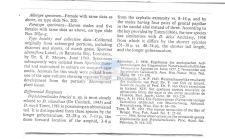
|
World Database of NematodesLinked to the Marine Biology Section, UGent |
| Start | Browse taxonomy |
Search taxonomy |
Search literature |
Search distributions |
Identification keys |
Media gallery | Editors | Statistics | Citations | Match taxa | Contact | Login |
Nemys taxon detailsDiplolaimelloides bruciei Hopper, 1970
121431 (urn:lsid:marinespecies.org:taxname:121431)
accepted
Species
marine
Hopper, B. E. (1970). Diplolaimelloides bruciei n. sp. (Monhysteridae: Nematoda), prevalent in marsh grass, Spartina alterniflora Loisel. <em>Can. J. Zool.</em> 48: 573-575. [details] Available for editors
Nemys eds. (2024). Nemys: World Database of Nematodes. Diplolaimelloides bruciei Hopper, 1970. Accessed at: https://nemys.ugent.be/aphia.php?p=taxdetails&id=121431 on 2024-07-26
Date action by
original description
Hopper, B. E. (1970). Diplolaimelloides bruciei n. sp. (Monhysteridae: Nematoda), prevalent in marsh grass, Spartina alterniflora Loisel. <em>Can. J. Zool.</em> 48: 573-575. [details] Available for editors
taxonomy source Fonseca, G.; Decraemer, W. (2008). State of the art of the free-living marine Monhysteridae (Nematoda). <em>Journal of the Marine Biological Association of the United Kingdom.</em> 88(7): 1371–1390., available online at https://doi.org/10.1017/S0025315408001719 [details] Available for editors basis of record De Smet, G.; Vincx, M.; Vanreusel, A.; Vanhove, S.; Vanaverbeke, J.; Steyaert, M. (2001). Nematoda - free living. <em>In: Costello, M.J. et al. (Ed.) (2001). European register of marine species: a check-list of the marine species in Europe and a bibliography of guides to their identification. Collection Patrimoines Naturels, 50.</em> 161-174., available online at https://www.vliz.be/nl/imis?refid=26605 [details] additional source Various Authors (2000). Nematode filing cabinet of the Marine Biology Section Ugent - in combination with the NemasLan Ms-Access database (published on CD-Rom, 2000) (look up in IMIS) [details] additional source Zhou, H. (2001). Effects of leaf litter addition on meiofaunal colonization of azoic sediments in a subtropical mangrove in Hong Kong. Journal of Experimental Marine Biology and Ecology, Elsevier, Amsterdam 256(1):99-121. [details] Available for editors additional source Hope, W. D. (2009). Free-Living Marine Nematoda of the Gulf of Mexico. <em>in Felder, D.L. and D.K. Camp (eds.), Gulf of Mexico–Origins, Waters, and Biota. Biodiversity. Texas A&M Press, College Station, Texas.</em> Pp. 1111–1123. [details] Available for editors additional source Jensen, P. (1983). Meiofaunal abundance and vertical zonation in a sublittoral soft bottom, with a test of the Haps corer. <em>Marine Biology.</em> 74: 319-326. [details] Available for editors additional source Jensen, P. (1984). Ecology of benthic and epiphytic nematodes in brackish waters. <em>Hydrobiologia.</em> 108: 201-217. [details] Available for editors additional source Moens, T.; Vincx, M. (2000). Temperature and salinity constraints on the life cycle of two brackish-water nematode species. <em>Journal of Experimental Marine Biology and Ecology.</em> 243(1): 115-135. (look up in IMIS), available online at https://doi.org/10.1016/s0022-0981(99)00113-6 [details] Available for editors additional source Moens, T.; Vincx, M. (2000). Temperature, salinity and food thresholds in two brackish-water bacterivorous nematode species: assessing niches from food absorption and respiration experiments. <em>Journal of Experimental Marine Biology and Ecology.</em> 243(1): 137-154. (look up in IMIS), available online at https://doi.org/10.1016/s0022-0981(99)00114-8 [details] Available for editors ecology source Dos Santos, G. A. P.; Derycke, S.; Fonsêca-Genevois, V. G.; Coelho, L.; Correia, M. T. S; Moens, T. (2008). Differential effects of food availability on population growth and fitness of three species of estuarine, bacterial-feeding nematodes. <em>Journal of Experimental Marine Biology and Ecology.</em> 355 (1): 7-40., available online at https://doi.org/10.1016/j.jembe.2007.11.015 [details] Available for editors identification resource Chen, Y.; Zhu, H.; Guo, Y. (2022). A new species and a new record of free-living marine nematode of genus Diplolaimelloides (Monhysteridae) from Futian mangrove reservation in Shenzhen, China. <em>Journal of Oceanology and Limnology.</em> , available online at https://doi.org/10.1007/s00343-021-1206-7 [details] Available for editors  Present Present  Inaccurate Inaccurate  Introduced: alien Introduced: alien  Containing type locality Containing type locality
|
Web interface and database structure initially created by Tim Deprez; now hosted and maintained by VLIZ
Page generated 2024-07-27 · contact: Tânia Nara Bezerra or info@marinespecies.org



